Serving 1,120 students in grades 9-12, Preston High School ranks in the bottom 50% of all schools in West Virginia for overall test scores (math proficiency is bottom 50%, and reading proficiency is bottom 50%).
The percentage of students achieving proficiency in math is 9% (which is lower than the West Virginia state average of 32%). The percentage of students achieving proficiency in reading/language arts is 41% (which is equal to the West Virginia state average of 41%).
The student:teacher ratio of 14:1 is higher than the West Virginia state level of 13:1.
Minority enrollment is 4% of the student body (majority Black and Hispanic), which is lower than the West Virginia state average of 12% (majority Black).
Quick Stats (2025)
- Grades: 9-12
- Enrollment: 1,120 students
- Student:Teacher Ratio: 14:1
- Minority Enrollment: 4%
- Graduation Rate: 83% (Btm 50% in WV)
- Overall Testing Rank: Bottom 50%
- Math Proficiency: 9% (Btm 50%)
- Reading Proficiency: 41% (Btm 50%)
- Science Proficiency: 20% (Btm 50%)
- Source: National Center for Education Statistics (NCES), WV Dept. of Education
School Overview
Preston High School's student population of 1,120 students has declined by 7% over five school years.
The teacher population of 80 teachers has stayed relatively flat over five school years.
Grades Offered
Grades 9-12
(offers virtual instruction)
(offers virtual instruction)
Total Students
1,120 students
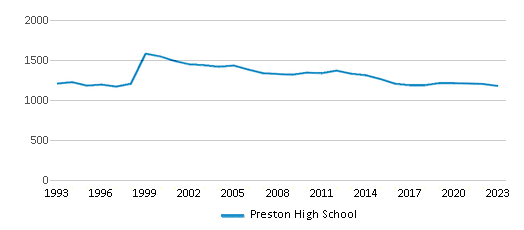
Gender %
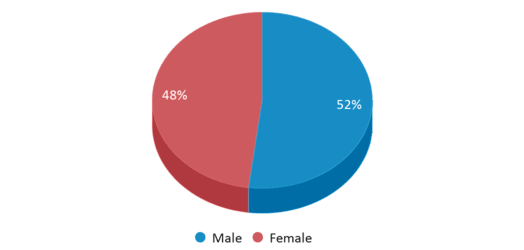
Total Classroom Teachers
80 teachers
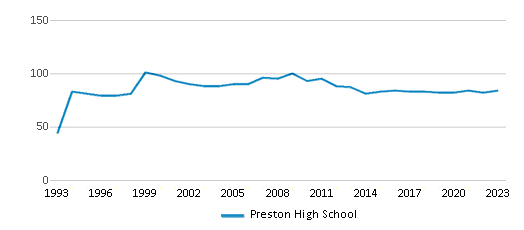
Students by Grade
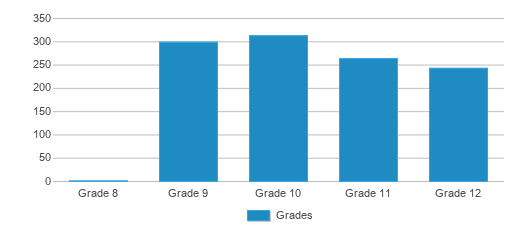
School Rankings
Preston High School ranks within the bottom 50% of all 627 schools in West Virginia (based off of combined math and reading proficiency testing data).
The diversity score of Preston High School is 0.08, which is less than the diversity score at state average of 0.22. The school's diversity has stayed relatively flat over five school years.
Overall Testing Rank
#518 out of 627 schools
(Bottom 50%)
(Bottom 50%)
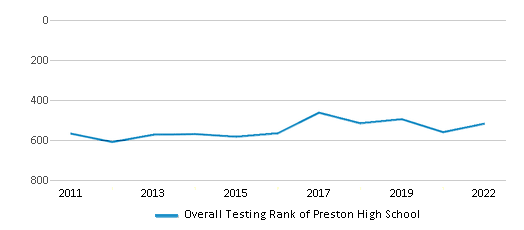
Math Test Scores (% Proficient)
9%
32%
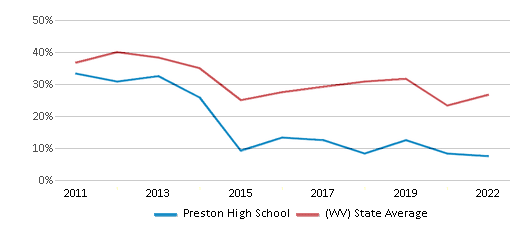
Reading/Language Arts Test Scores (% Proficient)
41%
41%
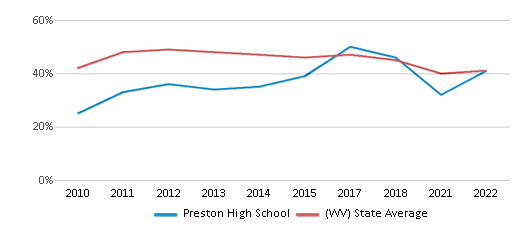
Science Test Scores (% Proficient)
20%
28%
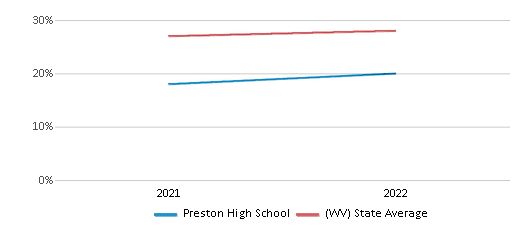
Student : Teacher Ratio
14:1
13:1
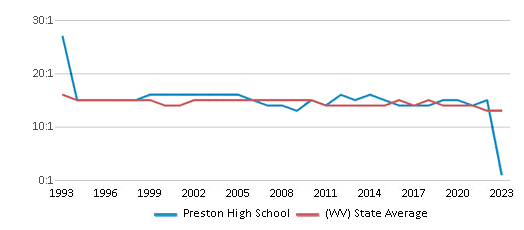
American Indian
n/a
n/a
Asian
n/a
1%
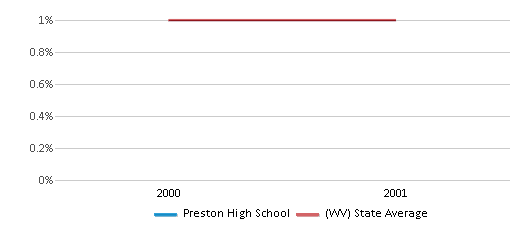
Hispanic
1%
2%
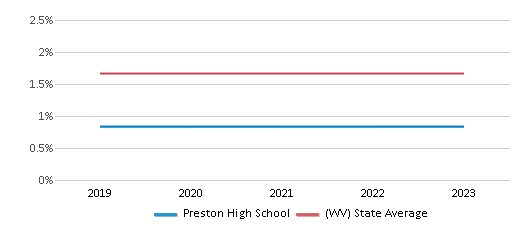
Black
1%
4%
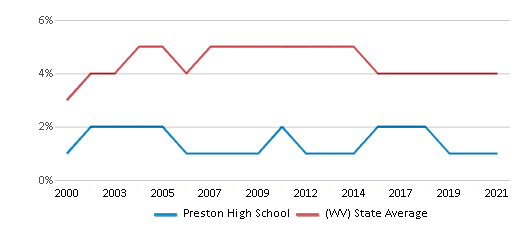
White
96%
88%
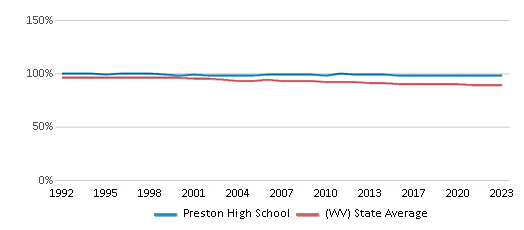
Hawaiian
n/a
n/a
Two or more races
2%
5%
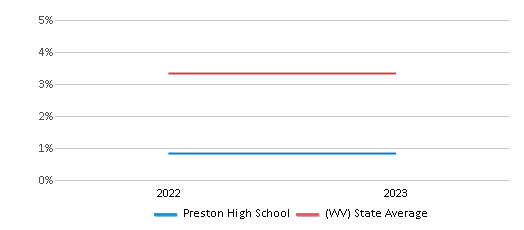
All Ethnic Groups
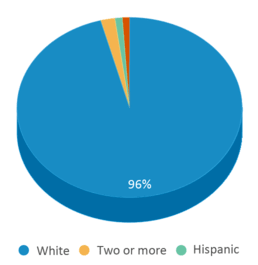
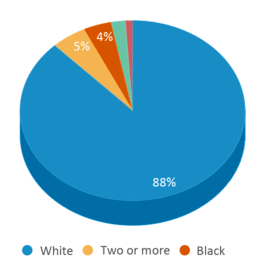

Graduation Rate
83%
91%
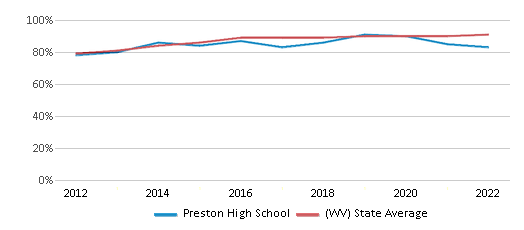
Eligible for Free Lunch
39%
50%
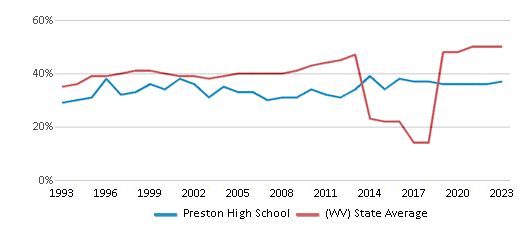
Eligible for Reduced Lunch
6%
5%
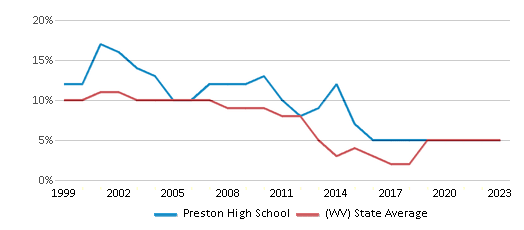
School Statewide Testing
School District Name
Source: National Center for Education Statistics (NCES), WV Dept. of Education
Profile last updated: 02/09/2025
Frequently Asked Questions
What is Preston High School's ranking?
Preston High School is ranked #518 out of 627 schools, which ranks it among the bottom 50% of public schools in West Virginia.
What schools are Preston High School often compared to?
Preston High Schoolis often viewed alongside schools like University High School, Morgantown High School by visitors of our site.
What percent of students have achieved state testing proficiency in math and reading?
9% of students have achieved math proficiency (compared to the 32% WV state average), while 41% of students have achieved reading proficiency (compared to the 41% WV state average).
What is the graduation rate of Preston High School?
The graduation rate of Preston High School is 83%, which is lower than the West Virginia state average of 91%.
How many students attend Preston High School?
1,120 students attend Preston High School.
What is the racial composition of the student body?
96% of Preston High School students are White, 2% of students are Two or more races, 1% of students are Hispanic, and 1% of students are Black.
What is the student:teacher ratio of Preston High School?
Preston High School has a student ration of 14:1, which is higher than the West Virginia state average of 13:1.
What grades does Preston High School offer ?
Preston High School offers enrollment in grades 9-12 (offers virtual instruction).
What school district is Preston High School part of?
Preston High School is part of Preston County Schools School District.
School Reviews
1 4/22/2020
The school is a very toxic place. The children there have no sense of empathy and are rude towards others. Little to no disciplinary measures are taken against these acts. The bathrooms are always dirty and lack stall doors. Each teacher has their own form of discipline and seem to shut out school wide rules in general. Many teachers fail to teach my child and leave the children to learn on their own. With this, online schooling (considering the recent circumstances) is almost impossible.
2 5/1/2012
Too many kids, teachers/admin can't keep track of. Students "slip through the cracks". Can't get anyone on telephone or to return any messages. Parents & students are pretty much on their own. If you want to talk to anyone there, you have to go to the school itself. Not bad if you live in area, but for people that are an hour away and have to work, it is impossible. The school doesn't communicate well with parents. My student complains that bathrooms are always dirty and no doors on stalls. School "can't afford" to spend money on things like new books or desks, but can spend away when it comes to football (and only football) even though they haven't won a single game in years. Can't speak on other sports other than they only spend money on football program. I'm not against football, but I think academics should come first, then sports programs . . . and all sports programs should be treated equally.
Review Preston High School. Reviews should be a few sentences in length. Please include any comments on:
- Quality of academic programs, teachers, and facilities
- Availability of music, art, sports and other extracurricular activities
Recent Articles

What Is A Charter School?
Explore the world of charter schools in this comprehensive guide. Learn about their history, how they operate, and the pros and cons of this educational innovation. Discover key facts about charter schools, including admission policies, demographics, and funding, as well as what to look for when considering a charter school for your child.

10 Reasons Why High School Sports Benefit Students
Discover the 10 compelling reasons why high school sports are beneficial for students. This comprehensive article explores how athletics enhance academic performance, foster personal growth, and develop crucial life skills. From improved fitness and time management to leadership development and community representation, learn why participating in high school sports can be a game-changer for students' overall success and well-being.

February 05, 2025
Understanding the U.S. Department of Education: Structure, Impact, and EvolutionWe explore how the Department of Education shapes American education, from its cabinet-level leadership to its impact on millions of students, written for general audiences seeking clarity on this vital institution.





